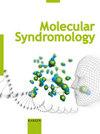CEP19 基因中一个新的同源 c.169C>T p.Arg57* 变异导致的严重早发肥胖症和糖尿病酮症酸中毒
IF 0.9
4区 医学
Q4 GENETICS & HEREDITY
引用次数: 0
摘要
导言:早发性重度肥胖症通常是由潜在的遗传疾病引起的,最近发现有几种基因可导致综合征和非综合征形式的肥胖症。中心体蛋白 19(CEP19)"基因编码一种中心体和纤毛蛋白。CEP19 基因的同源变异是导致早发重度单基因肥胖症的极为罕见的原因。在此,我们介绍一个土耳其家族的早发性重度肥胖症患者。研究方法进行桑格测序和全外显子组测序,以确定该家族的遗传病因。结果指标病例是一名 12 岁女性,表现为重度肥胖(体重指数为 62.7 kg/m2)、代谢综合征和糖尿病酮症酸中毒。她的非同卵双胞胎女性兄弟姐妹也早早出现严重肥胖、代谢综合征和糖尿病。此外,其中一个受影响的同胞姐妹还患有腹部坐位不正、多椎体减少症、腰椎融合和异常侧位。在该家族所有受影响成员的 CEP19 基因第 3 外显子中都检测到了一个新的同基因无义(c.169C>T,p. Arg57*)致病变异。一个未受影响的姐妹和未受影响的父母都是该变异的杂合子。据预测,该变异会导致第 57 个氨基酸序列出现终止密码子,从而导致 CEP19 蛋白质截短。讨论/结论:我们的研究扩展了 CEP19 变异的表型表现和变异数据库。其中一名患者的研究结果再次证实了 CEP19 在动纤毛和静纤毛的组装和功能中的作用。本文章由计算机程序翻译,如有差异,请以英文原文为准。
Severe Early-Onset Obesity and Diabetic Ketoacidosis due to a Novel Homozygous c.169C>T p.Arg57* Variant in CEP19 Gene
Introduction: Early-onset severe obesity is usually the result of an underlying genetic disorder, and several genes have recently been shown to cause syndromic and nonsyndromic forms of obesity. The “centrosomal protein 19 (CEP19)” gene encodes for a centrosomal and ciliary protein. Homozygous variants in the CEP19 gene are extremely rare causes of early-onset severe monogenic obesity. Herein, we present a Turkish family with early-onset severe obesity with variable features. Methods: Sanger sequencing and whole-exome sequencing were performed to identify the genetic etiology in the family. Results: The index case was a 12-year-old female who presented with severe obesity (BMI of 62.7 kg/m2), metabolic syndrome, and diabetic ketoacidosis. Her nonidentical twin female siblings also had early-onset severe obesity, metabolic syndrome, and diabetes. In addition, one of the affected siblings had situs inversus abdominalis, polysplenia, lumbar vertebral fusion, and abnormal lateralization. A novel homozygous nonsense (c.169C>T, p. Arg57*) pathogenic variant was detected in exon 3 of the CEP19 gene in all affected members of the family. One unaffected sister and unaffected parents were heterozygous for the variant. This variant is predicted to cause a stop codon at amino acid sequence 57, leading to a truncated CEP19 protein. Discussion/Conclusion: Our study expands the phenotypical manifestations and variation database of CEP19 variants. The findings in one of our patients reaffirm its role in the assembly and function of both motile and immotile cilia.
求助全文
通过发布文献求助,成功后即可免费获取论文全文。
去求助
来源期刊

Molecular Syndromology
Biochemistry, Genetics and Molecular Biology-Genetics
CiteScore
1.70
自引率
9.10%
发文量
67
期刊介绍:
''Molecular Syndromology'' publishes high-quality research articles, short reports and reviews on common and rare genetic syndromes, aiming to increase clinical understanding through molecular insights. Topics of particular interest are the molecular basis of genetic syndromes, genotype-phenotype correlation, natural history, strategies in disease management and novel therapeutic approaches based on molecular findings. Research on model systems is also welcome, especially when it is obviously relevant to human genetics. With high-quality reviews on current topics the journal aims to facilitate translation of research findings to a clinical setting while also stimulating further research on clinically relevant questions. The journal targets not only medical geneticists and basic biomedical researchers, but also clinicians dealing with genetic syndromes. With four Associate Editors from three continents and a broad international Editorial Board the journal welcomes submissions covering the latest research from around the world.
 求助内容:
求助内容: 应助结果提醒方式:
应助结果提醒方式:


